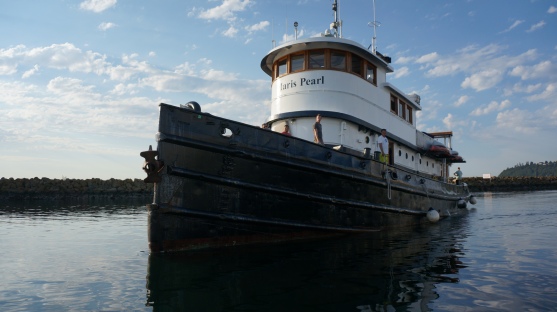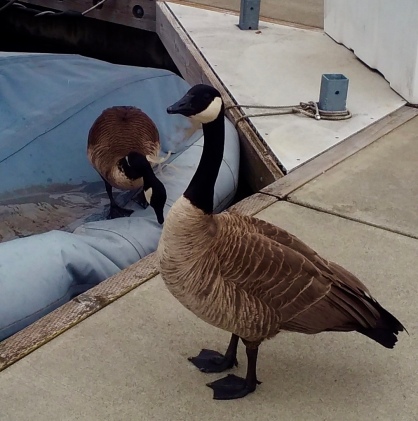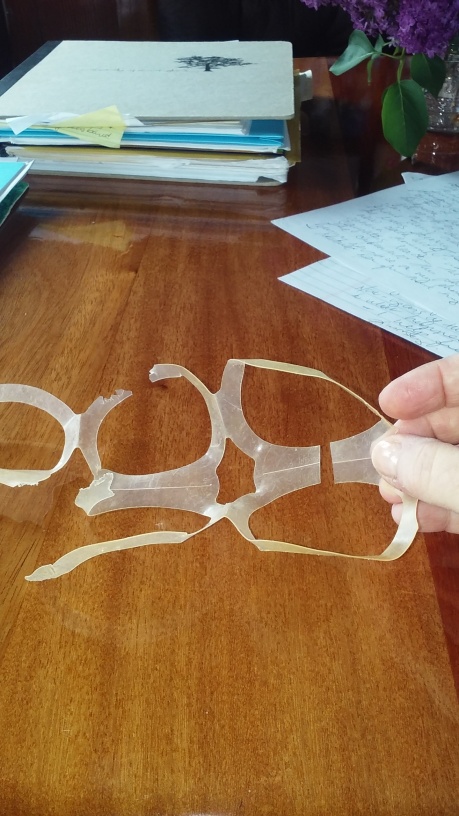Goose Noose

To balance out my story about the pernicious Don Gallo (see previous post), I thought I’d treat you to another story involving fowl. But this time, not foul fowl. Rather, fowled foul. I’m not messing with you, I promise. Read on and you’ll see.
I had the opportunity recently to spend a couple of weeks working on the Maris Pearl, a 1944 tug boat moored at the end of my dock. Our friends who live on this spectacular vessel let me use it while they were out of town. Having a dedicated work space allowed me to spread out. At the end of the day, I could leave everything as it was instead of gathering up and putting away all my papers and notes as I do on my own, smaller vessel. Returning the next day to exactly where I had left off increased productivity noticeably.

My office for two weeks – heaven…
My own boat/home is just a few slips away, so I walked back and forth several times a day to make coffee, eat lunch, use the head, and fetch whatever additional supplies I needed.
One day, on the way back to the Maris Pearl, fresh pot of coffee in hand, I saw a couple of Canadian geese just ahead. No big deal. Geese frequently patrol the docks (as do seagulls, crows, kingfishers, herons and a variety of water birds). Geese, in particular, swim by on summer evenings, just about the time grills are firing up and folks are gathering in cockpits to eat dinner. They have an uncanny sense of timing and apparently love progressive dinner parties.
However, this was a different sort of sighting. The male of the two stood guard as his mate drank rainwater that had collected in an upside down dinghy’s deflated bottom. My heart sank when I saw around her neck a tangle of six-pack plastic loops, which looked as though they had been there for a while and were tightening as she grew.


It was an in-your-face example of the photos posted on environmental websites and affirmation for why I always cut those things, when I buy them (which I will no longer do), into tiny pieces. I watched for a few seconds, trying to work out a way I could possibly help her. They were both on alert, but did not fly away. She would drink, and then peck at the plastic, obviously bothered by this foreign object around her neck.
What to do, what to do?
I raced back to my boat, grabbed a piece of bread and a pair of scissors, knowing the likelihood of getting close enough to snip the thing off was slim. Even if I managed to grab her, I had no idea how tightly bound her neck was and I knew that wing flapping and pecking would add to the challenge.
But I had to try.
They were no longer on the main dock when I returned, but I found them exploring a finger pier between two boats. I coaxed them toward me, breaking off small bits of the bread and tossing them just in front of me. They waddled on over like we were old friends. “Hey, how’s it going? Sure, we’ll try some of that. Is it gluten-free?” (It was.)
My plan was to:
- Hold out a large piece of bread with my right hand, enticing the female.
- When the female got close enough, grab the plastic around her neck with my left.
- Then I would reach for the scissors, strategically placed down by my right side, and snip.
The problem with the plan was evident immediately. The male was right there with her and, as I began to slowly reach for the female, he came toward me aggressively, hissing and sticking his weirdly human looking pink tongue out of his narrow black beak.
These birds are big enough to give pause. I was sure they would not hesitate to attack me, jabbing me with those hard, pointy beaks. While I was pondering and strategizing anew, the female grabbed most of the bread out of my hand and smugly waddled away.
I needed help. This was not a one-person job. On the pier where I was performing my futile attempt at heroics, lives my neighbor, Rado, a retired tech/engineer guy, who is usually at home, working on his boat. The cockpit was tarped over so I couldn’t visually confirm his presence.
“Rado?” I said. “Yes?” came the disembodied response from under the tarp. “Can you help me?” Rado peeked out of an opening in the tarp and his technical brain immediately assessed the situation. “Oh,” he said simply, and then opened the tarp, donned latex gloves and stepped out. Without saying a word, he began to walk, slowly, step by step, toward the goose — the way one walks when sneaking up on someone — arms extended in “ready to grab” position. I could see the female was beginning to panic.
“Crouch down,” I suggested, “so you are less intimidating.”
We worked at it for a while, throwing bread one way for the male, trying to distract him to buy us a little time but the gander was having none of it. As I was about to give up, Rado pounced and – oh joy! – he had the female in his hands. Her wings were flapping wildly and feathers were flying like snow in a wind machine.
“Try to contain her wings!” I cried. Miraculously he did. Rado is amazing that way. I went in with the scissors, made one easy cut and she was free. Rado released her and she padded to the end of the pier, a bit stunned, but then popped off the pier into the water. Her mate was frantic, honking and squonking desperately somewhere down the dock.
Rado and I stayed put after a hug and a high five, not wanting to further frighten them. The goose and gander honked and called to each other until at last, the distraught gander found his lady love and joined her in the water.
~~~~~~~~~~~
This is what was around her neck.

In the photos of the goose you can see where the curly bit is protruding off to the side. The rings on the left were doubled over and you can see where I snipped more clearly, below.

The two loops in my hand were around her neck but still loosely enough that I could make a clean snip without pulling on her neck.
Do I feel like a hero? Yes. Sort of. But to truly address this, I believe that we have to commit to getting rid of plastic – at least in our own lives. Innocent animals suffer because of our laziness and greed.
So what do we do? Plastic has become such a part of our lives that we don’t even think about it anymore. On my next trip to the grocery store after my goose encounter, I made a mental note of how many items I buy that have plastic in their packaging. Including twist ties, the seal around even glass bottles to prove they have not been tampered with, those little plastic square thingies that hold bags closed, the pour spouts in cardboard juice and milk cartons, etc.
I decided to become more conscious about my choices. To buy items in glass or paper containers only. To choose loose produce rather than bagged or plastic boxed produce. Even then, though, I reach for the plastic bags hanging by the produce to protect the lettuce or contain the peppers. It’s hard!
What about BPA-free plastic? Sorry – that is not the answer. I read that BPA-free plastics contain chemicals that rival toxic BPA and could even be WORSE for you. AND – it’s still plastic as far as the environment is concerned.
In Panama, there is an astonishing amount of plastic garbage on the beaches, most of it washed up from the cities and passing ships. Over the years I spent there, I realized that the overwhelming trash is less a reflection on the habits of the local culture, as many tourists surmise, than it is on the unnecessary and wasteful packaging of the products our sector of the world pushes on the rest of the world. It’s stunning to see it – to see how much there is. In parts of the world that have facilities for disposing of garbage and recyclable materials handy and user-friendly, we are shielded from the visual proof of the enormous amount of trash we produce. Out of sight, out of mind, right?
Sea birds and seals and whales are washing up on beaches, their bellies filled with plastic refuse. Chris Jordan, a Seattle based photographer has spent time among albatrosses on Midway Atoll, located 2000 miles from the nearest continent. His photographs of dead albatrosses’ remains, stomachs filled with plastic refuse, are devastating. If they don’t convince you to start sensitizing yourself to plastic consumption then nothing will.
One way to wrap your brain around changing your plastic habit is to try this 28 Day Plastic Purge Challenge. This may help you to start thinking differently and noticing just how often we unwittingly incorporate plastic into our lives.
I started today.



Doing a little part each day can make a big difference. I’m out on San Francisco Bay 4-5 days a week working race courses or teaching. Every time I am out there, I pick up some of this plastic refuse, including mylar balloon, bottles, styrofoam coolers ..even plastic chairs. We all need to start somewhere. Good on ya, for making a difference.
Such an inspiring story! I try to stay away from plastics too..will try even harder! Thank you for the great reminder!
Thank you. Thank you. Thank you. Such a poignant example of how our carelessness directly impacts our environment and the creatures that inhabit it.
Thank you for rescuing your neighbor in distress and for taking the time to share your story. Someday may we all protect our earth and one another with the dedication and courage shown by the male goose!
Stop buying plastic!
Well done!